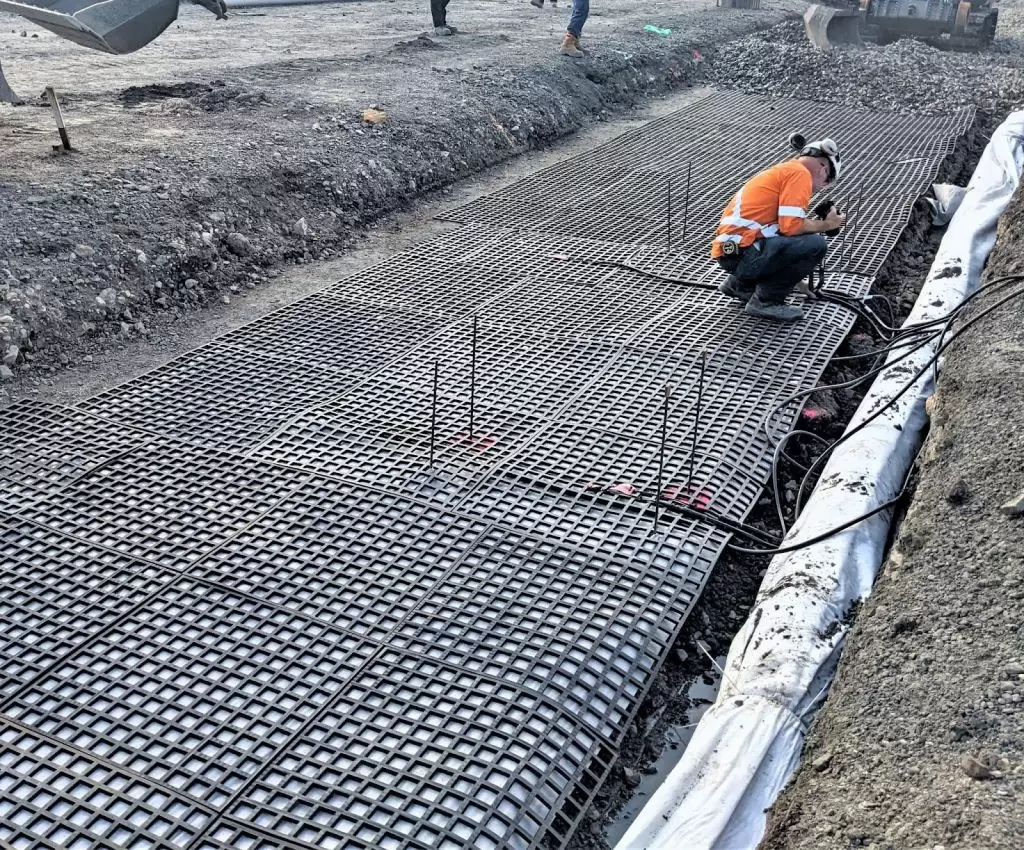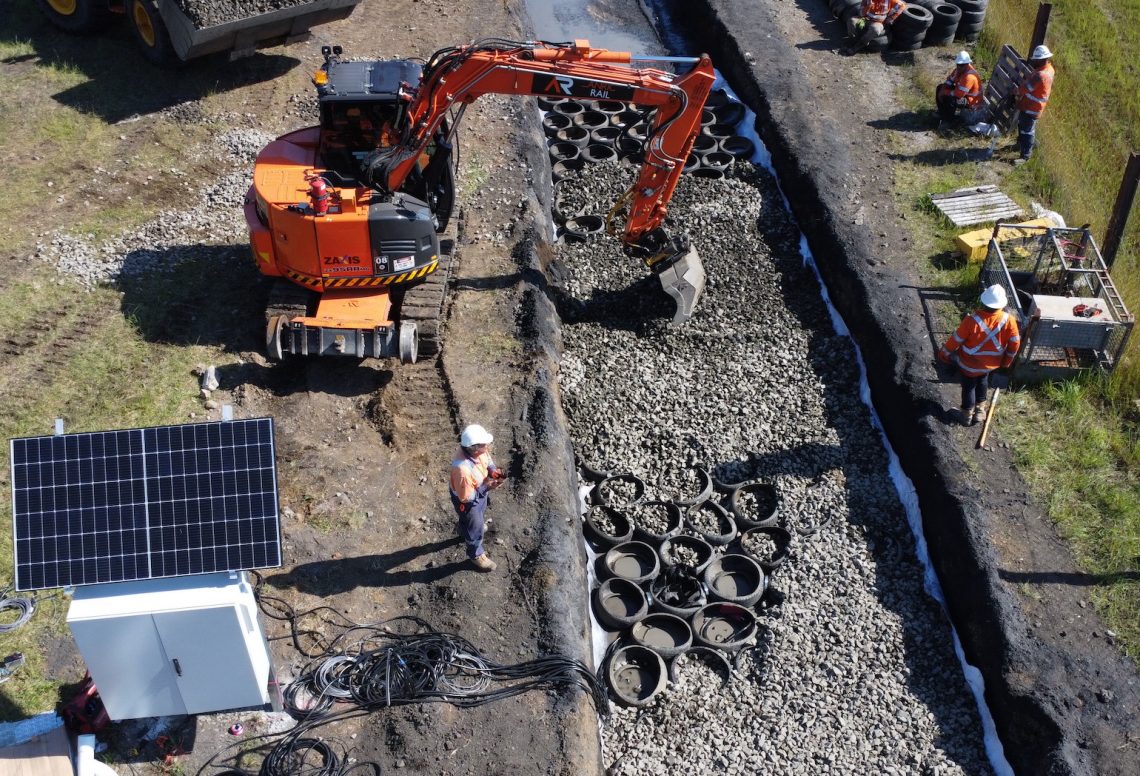A University of Technology Sydney (UTS) rail research project not only achieves its sustainability goals, it has been scientifically tested and proven to be superior to existing railroad technologies.
In the Sydney Trains rail yard in Chullora lies a new track design that, on the surface, appears standard. Underneath however, it makes innovative use of recycled rubber to absorb shock and increase the lifespan of granular construction material or ballast. Not only that, but the solution is sustainable on two fronts – it fares better in low-lying soft soil terrains or flood situations and it helps turn a serious environmental issue into a useful product.
“In Australia we throw away two tyres per person every year – over 40 million tyres annually, as well as many kilometres of conveyor belt rubber,” says Distinguished Professor of Civil Engineering Buddhima Indraratna. “That includes a massive number of large tyres, three metres in diameter, from mining vehicles and machinery.”
As Director of the UTS’ Transport Research Centre within the Faculty of Engineering and Information Technology, Indraratna has spent two decades researching improvements in rail track construction. He’s discovered that recycled rubber can help do that in a variety of ways.
Rubber grids
A recurring issue for railway engineers is the fact that, over time, train movements and environmental effects cause ballast particles to move around. Indraratna and his team are trying to prevent this through grids made of recycled rubber.
Using high-power waterjets, the researchers have been cutting grid patterns into waste conveyor belt sheets. These grids, also known as EARS (Energy Absorbing Rubber Seams), are then laid in between the ballast layer and the underlying capping (compacted sandy gravel) to help prevent particle movement and provide a level of shock absorption for the trains travelling above.

“The wheels of a locomotive are not always perfect circles,” says Indraratna. “Because of wear and tear, you get flat spots on steel wheels. When they rotate at speed, you get a hammer effect. The impact of these repeated forces is partially absorbed by the rubber grids, preventing damage to concrete sleepers, to ballast particles and to the train itself, apart from reducing excessive particle movement.”
Granular energy absorbing layer
What happens to the rubber that is cut out from the conveyor belt sheets? It’s ground into granular crumbs and blended in optimum proportions, with other industry by-products such as steel furnace slag and coal wash, and then compacted as a capping layer.
Known as SEAL (Synthetic Energy Absorbing Layer), this layer prevents excessive stress propagation to the soft natural foundation (subgrade). It helps to create a level of shock absorption so effective that train drivers will likely notice a smoother ride, says Indraratna.
Using whole rubber tyres
In the part of the process known as 2-REAL (Recycled-Rubber Energy Absorbing Layer), whole rubber tyres with one rim removed are laid in a grid pattern, creating a subterranean rubber framework that reduces lateral displacement of the ballast and helps prevent breakage.
“You can easily infill the tyres with granular industry wastes and compact that material, such as a blend of spent ballast, coal wash, steel slag and rubber crumbs, to get a material that can absorb energy, and provide a foundation that is also an energy retaining reservoir,” says Indraratna.
This technique has never been applied in railways and is a pending patent in collaboration with EcoFlex Australia.

Because hundreds or thousands of these whole tyres can support the sub-ballast, their shock absorbing quality can also help to reduce noise and vibrations.
Rubber granules reduce ballast breakage
It’s important that weight-bearing ballast must be of the highest quality. One problem faced here for rail engineers is that quarry product is becoming more difficult and expensive to source. Another is that in traditional rail engineering ballast stones break down quickly especially with the increased axle loads of trains.
Rail authorities often spend over $15 million annually to replace ballast and repair associated damage in NSW alone, says Indraratna.
Indraratna conducted research to identify the size of ballast stones that are most vulnerable to breakage. They are then replaced with similar sized and shaped pieces of recycled rubber aggregates to provide an integrated mix known as RIBS (Rubber Intermixed Ballast System).
“Recycled rubber costs next to nothing, is in plentiful supply and you can’t easily break rubber aggregates,” he says. “These rubber particles, when mixed with the natural quarry aggregates, give a cushioning effect by reducing the attrition between the rock particles. In doing so, they extend the life of the ballast layer.”
Testing and refining
In both computer modelling and real-life scale physical simulations at the Russel Vale testing facility, Indraratna’s research has proven that the abovementioned applications are superior not only to Australian standards but to global rail standards, and this will be confirmed through real-world testing soon at the Chullora Rail Yards.
Several of the discoveries now have patents pending and Indraratna’s team at UTS is currently looking to partner with industry on various aspects of the projects.
“This is not just a way of getting rid of waste. That is a collateral benefit but not the main one,” he says.
“The main benefit is that these applications are scientifically superior. The tracks undergo less settlement and the tracks and trains that use them require less maintenance. A lot of money is saved in extending the lifecycle of the tracks, including the concrete sleepers and the ballast.”
To find out more about UTS’ Transport Research Centre and its work, visit its website.





How TfNSW support this initiative and whether they have started to standardize it?